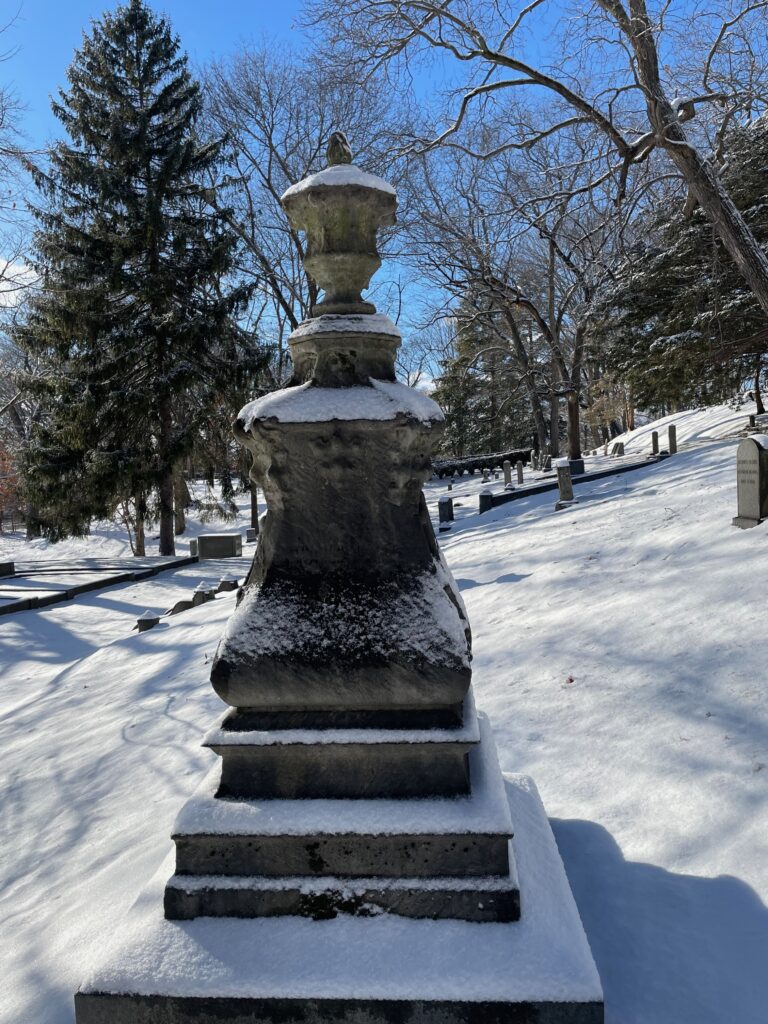Erik Visits an American Grave, Part 1,910
This is the grave of Nathaniel Silsbee.

Born in 1773 in Salem, Massachusetts, Silsbee grew up in a shipping household. His dad was a merchant and sea captain. Something happened and his father went bankrupt and that forced his son onto the sea early, He went to sea in 1787, only 14 years old, working on ship and learning how to navigate. The family was connected enough that he wasn’t working the horrible jobs on the ship with no chance to advance, but rather to train to be a captain himself someday. He was quite good and came to the attention of the wealthy merchant Elias Hasket Derby. By the time he was 19, Derby hired him to command one of his ships. One wonders what the older crew thought about being bossed around by a kid, but given ship discipline, I guess they wouldn’t have had much of a choice about it. This wasn’t any little trip to Havana or something either. He commanded the ship around the Cape of Good Hope and all the way to India, with a valuable cargo. Pretty clear that Derby thought the world of the kid to entrust him with this, although unlike today, you don’t have to be in your 60s for anyone to think you are mature enough to lead in anything.
Silsbee rose to make a fortune in shipping. He owned his own ship by 1795. In 1801, partnering with the merchant Dudley Leavitt Pickman, he started his own merchant house in Salem. Starting that year, he mostly had his brothers do the ship captaining, while he stayed on shore to manage the business operations. He was successful in doing this and over time, became interested in politics.
Silsbee ran for Congress in 1816 and was elected. Political experience didn’t mean much to be in Congress and to be honest, it doesn’t mean much today either. He served two terms and was chair of the House Committee on Military Pensions. He decided not to run again in 1820. Unlike today, when members of Congress, especially Democrats, think a 30 year career in Washington is just a bit too short, people at that time routinely would serve a term or two and that’s it, wanting to go back home or try their hand at different stuff. In this case, Silsbee wanted to be a state representative rather than be in Congress instead. This is kind of hard to wrap your head around in contemporary politics; no one would make this choice. But it was a very different world. I don’t really know why Silsbee himself made this choice. Perhaps it was easier to focus on his business interests, perhaps to be closer to his family in an age before the train made getting home realistic, perhaps he thought he could be effective in Boston than in Washington. Anyway, he did one term in the Massachusetts House and then moved over to the state senate. He was president of the Senate from 1823-25.
In 1826, James Lloyd resigned from the Senate, which also happened all the time. I’d guess at this time that maybe half of senators completed a term and we’ve seen this over and over in this series. No Democratic gerontocracy in this age! So the state sent Silsbee to Washington again. He finished that term and then was elected in his own right in 1828. He did not try for a second full term in 1834 and returned home in 1835. These were the years when the second party system was in formation and Silsbee became a good Whig, as one would expect from his region and shipping interests. He was also chair of the Senate Committee on Commerce, probably a good position for a guy like this. Silsbee noted that such a position was an “honor,” and it’s worth noting that there weren’t that many committees at this time, so to head an important one such as Commerce did show that you were respected among your colleagues. However, it seems that Silsbee was not particularly a leader on issues outside of his merchant and related interests, as the literature on the other political issues of the time rarely mentions him.
In 1831, when one of Silsbee’s ships, ironically called the Friendship, was trading in Sumatra, the local people, evidently sick of the violence that so often accompanied American traders or perhaps they just wanted a good raid, revolted against the ship and killed a bunch of the sailors. The trade there was in black pepper and Silsbee demanded that Andrew Jackson, then president, do something about this attack on his interests. Jackson was down with that. He had the Navy prepare an expedition. Levi Woodbury, then Secretary of the Navy, stated that “every necessary preparation be made to demand immediate redress for the outrage committed.” When was Jackson going to not want to kill some people, especially if they weren’t white? This became the first American intervention in southeast Asia. In the Battle of Quallah Battoo, about 450 Sumatrans were killed and 2 Americans, stopping Sumatran attacks on American ships for the next several years. This would not be the last time the United States would send troops to southeast Asia.
Silsbee spent his later years working on his commercial interests in Salem. His daughter married Jared Sparks, the early historian and president of Harvard in the late 1840s and early 1850s. Silsbee died in 1850. He was 77 years old.
Nathaniel Silsbee is buried in Burying Point Cemetery, Salem, Massachusetts.
If you would like this series to visit other senators elected in the 1828-29 cycle, you can donate to cover the required expenses here. Nehemiah Wright is in Cranston, Rhode Island (OK, granted this is 15 minutes from my house so I can probably handle that one) and John Clayton is in Dover, Delaware. Previous posts in this series are archived here and here.


